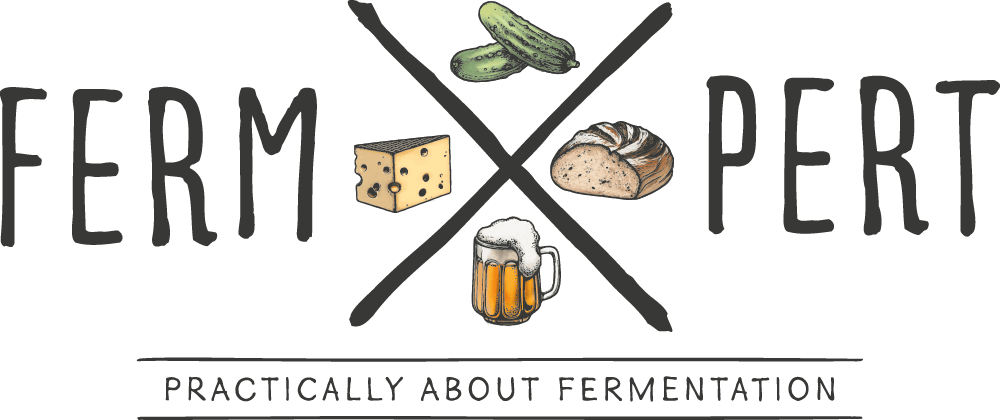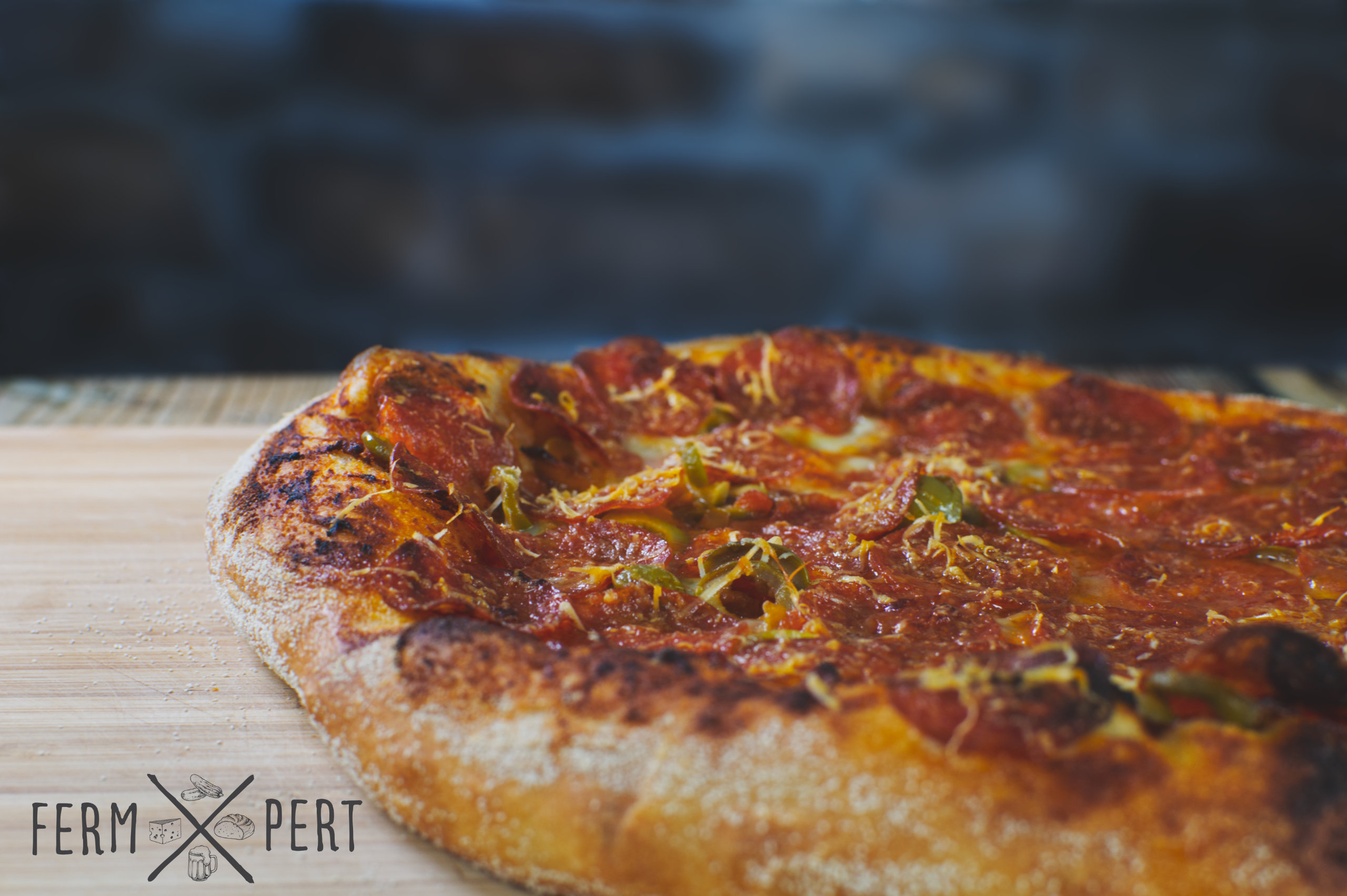While it’s a simple dish, pizza has always been something special to me. Even though my family have never really got into the habit of eating in restaurants, the pizzeria has always been an exception. We used to go to three different ones, and the pizza served in each was unique and special in its own way. This was a few decades ago. Nowadays, I can’t even count how many pizzerias I’ve eaten at, how many pizza styles I’ve tried or how many different toppings I’ve used. I’ve even worked in an Italian pizzeria, so I guess I’ve got to know pizza from many different perspectives. Today I’ll share the recipe that I like to use at home.
Recipe
- 300 g strong white wheat flour (all purpose should be OK too)
- 180 g water
- 6 g fresh yeast or 3 g dried yeast
- 6 g salt
- semolina for dusting the work surface
- 400 g tomato purée
- 1 large clove of garlic
- 1 tsp dried oregano
- 150 g mozzarella
- 50 g parmesan
- toppings of choice
Mix the water, yeast, salt and flour and knead for 10 minutes until a strong gluten network is formed. Prove covered until the dough doubles in size.
Pour the tomato purée into a pot and heat until it reaches the boiling point. Simmer until the sauce reaches the desired thickness. A few minutes until the end of the boil, add finely minced garlic. After the boil, add oregano.
Divide the dough into two pieces of equal size. Form two dough balls and let them prove on the counter for another 15 to 30 minutes. Sprinkle semolina over the counter and stretch the dough balls into pizza bases with the diameter of 25-30 cm (10-12 inches). Place the bases on pizza baking sheets.
Spread tomato sauce over the bases. Sprinkle with chopped mozzarella. Add toppings and finish off with grated parmesan.
Preheat the oven to the maximum temperature setting and bake until golden brown.
Additional Information
In case of Italian pizza, the flour type 00 is generally used, but this type only indicates a very fine milling, not the protein content. From my experience, pizza comes out best when the flour contains at least 12% protein. It’s also possible to replace part of the white flour with wholemeal.
The tomato sauce can be made from purée, fresh or canned tomatoes. In the latter case, it’s best to buy whole canned tomatoes and blend them along with the garlic. One can should be fine for two pizzas.
The pizza type that I make the most often is pepperoni and green olives. I think green olives work much better here than black, taste-wise. Sometimes I go crazy and add hot peppers too. This is a rather heavy combination, providing around 900 calories.
Sliced button mushrooms and a few slices of roughly cut prosciutto cotto is another great combination. It’s also more diet friendly, at little more that 600 calories. I sometimes enrich this combo with some diced bell peppers.
The variation I prepare the least often is salami, black olives, red onion and pickled jalapeños. I like to make the sauce spicy here too, either using powdered piri piri peppers or simply using homemade hot pepper sauce. Calorie-wise, this version is somewhere in the middle between the other two.
Video Transcription
I don’t know what makes pizza so attractive. There really isn’t anything fancy about it and yet I’ve always felt it’s a real treat. Luckily it’s not difficult to make at home. The full written recipe with the ingredient amounts and my favourite topping examples can be found on the blog.
For the base, I’ll need strong white wheat flour, water, salt and yeast. As usual, I’m going with fresh yeast, but dried will do just as well.
I pour water into a bowl, followed by the yeast and salt. I like to give everything a quick mix before continuing so that the yeast and the salt are somewhat dissolved and evenly dispersed. Once I’m done, I add the flour.
I give the dough an initial mix to roughly combine the ingredients. As soon as they somewhat come together, I flip the dough onto the counter. The sticky bits are only there because the water isn’t yet evenly distributed. My dough is a low hydration one and it should quickly become easy to handle. I knead it until I see good gluten development.
After around a minute, I’m not even able to properly do the windowpane test. The dough tears immediately. This means gluten formation is far from perfect. Ten minutes later I repeat the windowpane test and now the dough can be stretched very thin before it starts tearing. It’s smooth and elastic, just the way it should be. This indicates good gluten development.
I round the dough ball and pop it into its bowl. I cover it to prevent drying. It will prove until it doubles in size.
In the meantime, I’ll prepare the tomato sauce. I need some tomato purée, homemade in my case, a bit of garlic and some dried oregano.
I pour the tomato purée into a pan. It has already been boiled before jarring, but I like my sauce a bit more concentrated, so I’ll simmer it some more until I find the thickness just right. While the sauce simmers, I stir it occasionally to prevent it from burning.
When the sauce is close to ready, I start preparing the garlic. I peel it, crush it and mince it as finely as I can. A garlic press would have worked well too. Once it’s as fine as it gets, I toss it into the sauce. I stir it in and let the sauce simmer for a couple minutes more.
When the sauce is ready, I turn the stove off and add the prepared oregano. Now I can set the sauce aside and use it when the pizza bases are ready.
My toppings today include pepperoni, pickled bhut jolokias, and green olives. Mozzarella and parmesan are non negotiable.
While often just torn to large chunks, I prefer my mozzarella roughly diced. The olives get sliced. And the peppers get minced fairly finely.
Now, back to the dough. It has risen nicely, so I flip it onto the counter and knock it back, or remove gas from it by folding it a couple times. Then I divide the dough into two roughly equal portions. I round them and let them rest for fifteen minutes to half an hour. This will reinflate the dough a bit and relax the gluten mesh, making the dough balls stretchier.
When it’s time to form the pizza bases, I sprinkle a generous amount of semolina on the counter and cover both sides of the dough ball. Regular flour will work too. I flatten and stretch the dough ball until it either becomes the right size or gives too much resistance. If that happens, I move on to the other pizza base while the first one rests. Just a minute or two should be enough to relax the gluten mesh a bit and make the pizza base stretchy again.
Once a base is done, I place it on a pizza sheet sprinkled with some more semolina. Now it’s ready to receive the sauce and the toppings.
First goes the sauce. I try to spread it somewhat evenly, but without going all the way to the edge of the base. Then, I toss in the mozzarella. The olives and the hot peppers come next. Pepperoni. Freshly grated parmesan. And then it’s oven time.
And here’s the final result. The edge is puffy and crunchy, with an occasional charred spot here and there, exactly the way I like it. The smell is fantastic. And so is the taste, it even makes me forget how hot this pizza is. It’s so good it makes every burn on my palate worth it!

